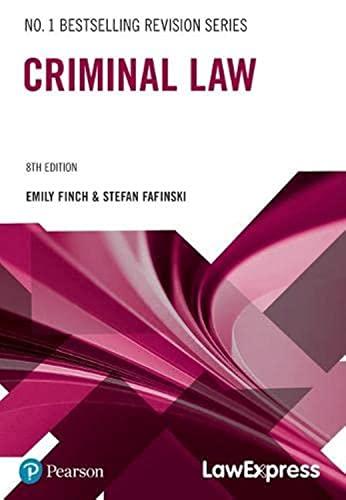Question
11. The implies that prices do which of the following? (A) All individuals get exactly what they need. (B) If prices for goods exist, rationing
11. The implies that prices do which of the following?
(A) All individuals get exactly what they need.
(B) If prices for goods exist, rationing is not necessary since scarcity no longer exists.
(C) Goods are allocated based on the ability and willingness to pay for a good.
(D) Individuals are free to pay whatever they wish for an item, regardless of how much it costs to produce.
(E) Private ownership of goods means that prices aren't necessary to ration goods.
system in the way a government might coordinate the allocation of goods in a non-market-based economy.
12. Which of the following would be counted in the category of resources called ?
(A) Money raised by firms through issuing stocks.
(B) The time it takes for an intervention to get a patent.
(C) The ability of a business owner to combine resources
(D) The common stock that a family owns in a firm
(E) The factory that a firm uses to produce goods.
13. The four economic resources are
(A) Land, labor, capital, money
(B) Natural resources, capital, land, money
(C) Land, entrepreneurial ability, capital, labor
(D) Land, income, capital, entrepreneurial ability
(E) Income, inflation, capital, land
14. In the production of cookies, which of the following would be considered the economic resource of land?
(A) The wheat flour used in the cooking dough
(B) The bowl you use to mix the cooking dough
(C) The work of the person mixing the cooking dough
(D) The recipe to mix the cooking dough
(E) The rack to cool the finished cookies
15. Suppose a caf owner wants to increase the number of people she can serve lunch to and is considering
whether to put in more tables or hire another server. Which two resources is the owner considering as
substitutes in production?
(A) Labor and land
(B) Labor and entrepreneurial ability
(C) Labor and capital
(D) Capital and entrepreneurial ability
(E) Capital and land
16. Which of the following categories of economic resources would describe heating oil for a home furnace?
(A) Entrepreneurship
(B) Land
(C) Investment
(D) Capital
(E) Labor
17. Max is considering going to culinary school to become a chef. Which of the following considerations
captures the idea of his implicit opportunity costs?
(A) How much money he can borrow to pay tuition
(B) How much hours per week he will work as a chef once he graduates
(C) How much tuition he will have to pay
(D) How many years it will take to him to graduate
(E) How much income he will forego when he quits his current job
18. Eli is deciding whether or not to provide his employees with a retirement plan. Which of the following
statements would be considered normative?
(A) Employees may have more incentive to work harder if he provides a retirement plan.
(B) Employees may save more on their own if he provides a retirement plan.
(C) Employers have a moral obligation to provide employees with retirement plans.
(D) Employees may be less likely to quit their jobs for another position if he provides a retirement plan.
(E) The retirement plan will cost him at least $500,000 per year.
19. Joe is a college football player considering whether to attend another year of college or to enter the NFL
draft and become a professional football player. Which of the following thoughts reflects the concept of
marginal analysis?
(A) Another year of college football will make me better prepared in the future, but I risk getting injured if I
do so.
(B) I should have a college degree.
(C) If I continue in college, I will give up $405,000 in income.
(D) I played on average 10 games per year as a college player and will play an average of 15 games per year
in the NFL.
(E) If I continue in college, I will give up a salary as well as potential income from endorsing products.
20. Amanda gets an additional $20 in income for working an additional hour, but she has to pay $25 in child
care costs. Based on this information, we can say that Amanda should _________ because ____________.
(A) Work more hours; marginal costs exceed marginal benefits
(B) Work fewer hours; marginal costs exceed marginal benefits
(C) Work more hours; the opportunity cost of working is $45
(D) Work fewer hours; the opportunity cost of working is $45
(E) Continue working the same amount; the opportunity cost of not working exceeds the opportunity cost
of working
Step by Step Solution
There are 3 Steps involved in it
Step: 1

Get Instant Access to Expert-Tailored Solutions
See step-by-step solutions with expert insights and AI powered tools for academic success
Step: 2

Step: 3

Ace Your Homework with AI
Get the answers you need in no time with our AI-driven, step-by-step assistance
Get Started


